A Fracking Boom Ransacks the Four Corners
Native American activists in northwest New Mexico are putting up a firm resistance as the U.S. Bureau of Land Management hands over their homeland to allies in the oil and gas industry.
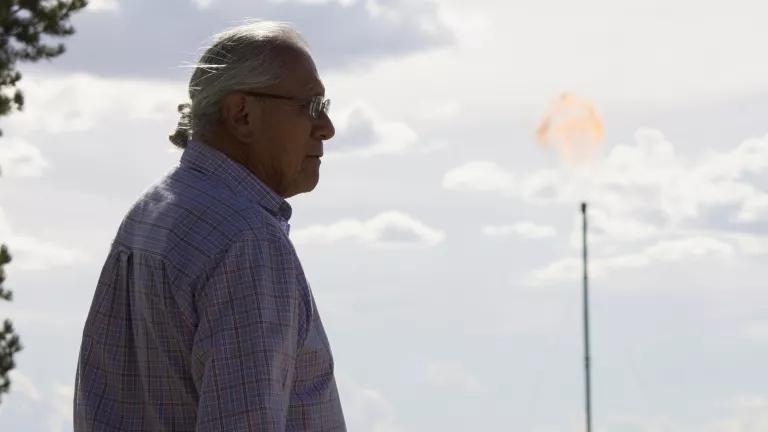
Navajo activist Daniel Tso near an oil well northeast of Chaco Culture National Historic Park
UPDATE: On May 7, 2019, the 10th Circuit Court of Appeals held that the Bureau of Land Management illegally approved oil and gas drilling and fracking in the Greater Chaco region. The court specifically reversed the approval of 25 drilling permits; however, the case has implications for hundreds of drilling permits that have been approved in the area.
The sandstone mesas around Chaco Culture National Historical Park deserve contemplative quiet, in respect to the Pueblo people who built this masonry marvel of ceremonial buildings and monumental plazas around AD 850. But up here, tranquility is in short supply. Instead, much of this high-desert corner of northwest New Mexico, home to several American Indian tribes, has become a noisy industrial wasteland, its hush disturbed by some 23,000 active oil and gas wells, its flats rutted by service roads, its air tainted with methane, hydrogen sulfide, and other noxious by-products of fracking.
The toxic dangers became clear on the night of July 11, 2016, when residents of the tiny Navajo village of Nageezi were shaken awake by exploding wells and fireballs hurtling over their homes. It was just the type of conflagration that longtime Navajo activist Daniel Tso had been predicting for five years, ever since the fracking boom took hold of the region.
“There is a total disregard for the people living here,” says Tso, who has been mapping fracking operations across the San Juan Basin, a 7,500-square-mile area covering parts of New Mexico and Colorado near the Four Corners. “They’re having to breathe in hydrogen sulfide and methane and other hazardous gasses on a daily basis.” His opposition is gaining traction among residents; in November, he beat a pro-industry incumbent to win a seat on the Navajo Nation Council.
According to an NRDC report, people living near fracking sites are exposed to air pollution that can cause a number of serious health impacts, from birth defects and blood disorders to cancer. Fracking’s toxic by-products also spread by water. A 2017 U.S. Environmental Protection Agency study noted that hydraulic fracturing activities have resulted in “impacts on drinking water resources, including contamination of drinking water wells.” Nonetheless, Tso says federal officials ignore those threats when handing out drilling permits.
Chaco Culture National Historical Park faces its own perils. Although drilling is prohibited within this UNESCO World Heritage Site, the intense surrounding activity affects the way of life for American Indians, who consider the ruins sacred. Cultural roots here run profoundly deep; a structure called Pueblo Bonito, considered the heart of the Chacoan universe, was constructed by ancestors of New Mexico’s Pueblo peoples between AD 850 and 1150. Nearby canyon walls are marked by their abundant petroglyphs and paintings; other rock art depicts traditional Navajo ceremonies.
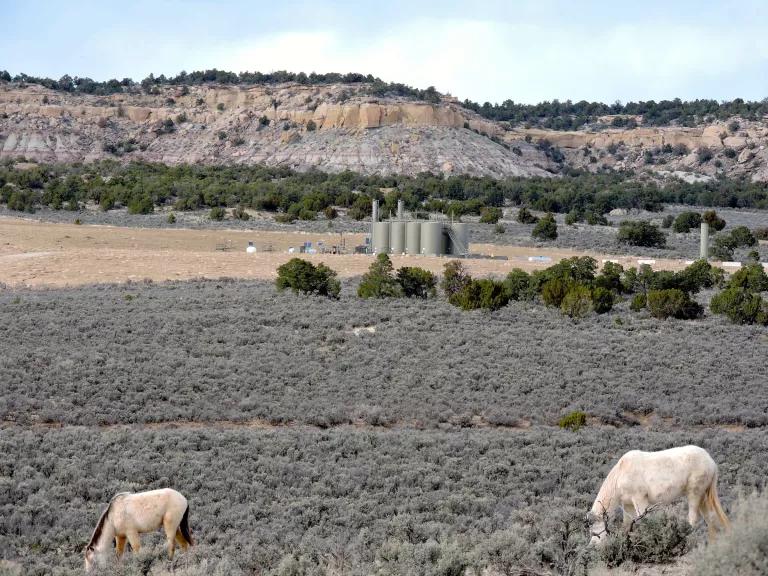
Horses grazing near gas and oil equipment in the Greater Chaco region
Outside Chaco, most nontribal areas of the San Juan Basin are controlled by the U.S. Bureau of Land Management, which has been approving drill sites at a rapid-fire pace. During the January partial government shutdown—and despite protests from activists—the BLM announced the auction of several new parcels near Chaco for gas and oil development.
Overwhelmed by the rush, Tso and other Native American activists eventually turned to outside organizations such as NRDC and WildEarth Guardians for help. Along with the Navajo group Diné Citizens Against Ruining Our Environment (Diné CARE) and others, they put together the Frack Off Greater Chaco Coalition. “We are a very small population with limited political influence, little information on the total development and leasing processes, and zero resources to put together a study and do monitoring,” Tso says. “But the Greater Chaco Coalition has 110 individuals and NGOs that are our allies now.”
Members lobby elected officials and protest at BLM offices urging the agency to beef up its bare-bones environmental and cultural reviews. Still, this is a game of catch-up; more than 90 percent of federal lands in the San Juan Basin have already been leased to oil and gas companies. And government officials show little interest in slowing down, particularly under the Trump administration, which has pushed to minimize buffers around Chaco and expand fossil fuel development throughout public lands.
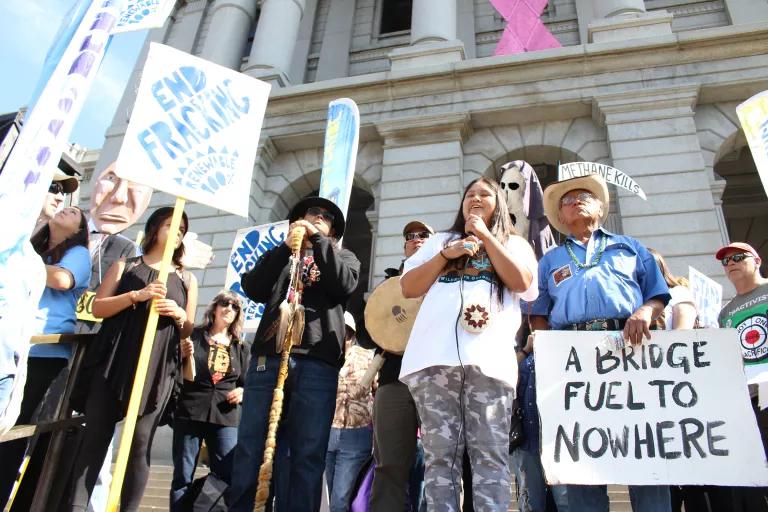
WildEarth Guardians activists and Chaco community members (Daniel Tso pictured on right) joining a national convening of anti-fracking activists in October 2015 to call for an end to fracking in Chaco
Agency representatives even walked out of a 2016 meeting on the Navajo Nation after the community asked the BLM to allow attendees to openly discuss their concerns about drilling and fracking on sacred lands. In March 2018, protests led then-Interior Secretary Ryan Zinke to delay lease sales within a 10-mile buffer zone around Chaco—but three months later, the feds charged ahead with leasing other lands in the region. Meanwhile, activists have kept up pressure on the agency to rein in the drilling frenzy. Last December at BLM offices in Santa Fe, they hand-delivered more than 10,000 individual comments opposing further leasing.
Courting Disaster
The BLM last issued a resource management plan for the San Juan Basin in 2003, a few short years before emerging production technologies would create vast new potential across the region. But the agency failed to consider the cumulative impact of so many new wells. Instead, it promised an amendment to the 2003 planning document to analyze the impacts of fracking in the area, while continuing to issue permits to drill.
In response, NRDC, Diné CARE, the San Juan Citizens Alliance, and WildEarth Guardians, represented by the Western Environmental Law Center, sued in 2015 to halt to further permitting until the BLM complies with the National Environmental Policy Act. The lawsuit also called out the agency for not analyzing the indirect and cumulative impacts of drilling on cultural sites, as required by the National Historic Preservation Act.
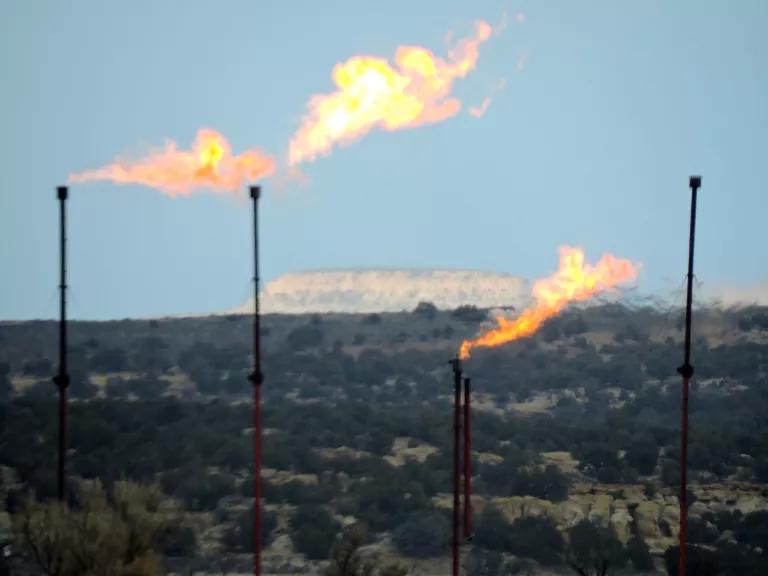
Flares from natural gas drilling on public lands
But a legal resolution has proved elusive. Last year a federal judge dismissed the suit, finding that BLM complied with the National Environmental Policy Act and did not violate the National Historic Preservation Act because it considered the effects of drilling on historical sites. The citizen groups subsequently took the case to the Tenth Circuit Court of Appeals. “The Bureau of Land Management failed to analyze the indirect and cumulative impacts of the challenged drilling approvals on natural resources and cultural sites in the Greater Chaco landscape,” says NRDC senior attorney Alison Kelly. “This analysis must be completed and adequate protections put in place before these important resources are forever lost to fossil fuel development.”
At the same time, the BLM has moved to decrease public oversight, squeezing the permit challenge and comment period from 30 days down to 10 and suddenly refusing to accept comments by email or fax. Instead, all opinions must now be delivered by hand or via regular mail—even as the agency proudly expands its ability to accept drilling applications online.
To Lori Goodman of Diné CARE, these changes reflect a too-cozy relationship between the extraction industry and the BLM. “This is all about the energy companies coming in as fast as they could and cutting through all regulations while the management plan was being amended,” she says. “Community people asked for a moratorium—no more oil and gas permits until the amendment was finished. The BLM stated that was not necessary.”
Protecting Antiquity
While the oil and gas industry sinks its teeth deeper into the Four Corners region, residents and admirers of the landscape are witnessing the destruction of centuries of culture. Many archaeologists see the Chaco Culture National Historical Park’s ancient structures as on par with Egypt’s pyramids in their significance.
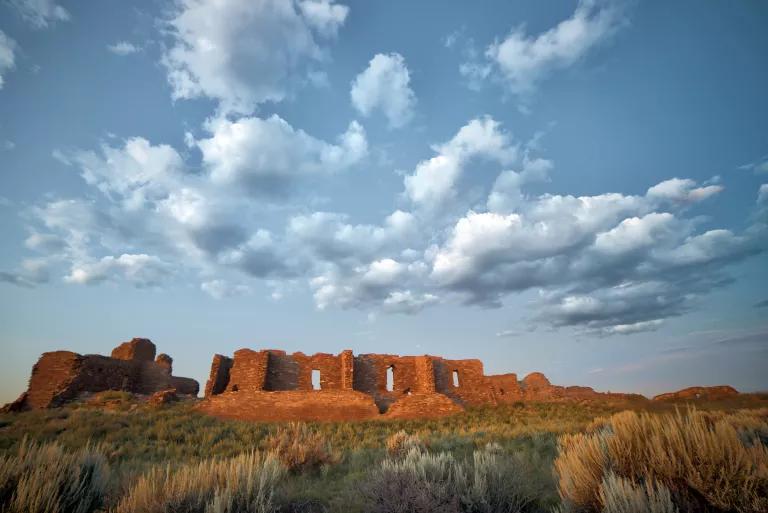
Pueblo Pintado in Chaco Culture National Historical Park
“We’ve seen more and more of the Chaco landscape being fragmented,” says Paul Reed, an archaeologist with Tucson-based Archaeology Southwest. “The irony is that these agencies think they’re doing a good job, from what we can tell. They identify archaeological sites, and those sites are avoided. They move 100 feet away with an oil pad or a road or something. But over time, the landscape is becoming more chopped up and compromised. We find that unacceptable for this World Heritage site.”
Reed and others are pushing for a 10-mile buffer around the park where no drilling would be allowed, a concept that last year landed in a bill introduced by Senator Tom Udall (D-NM). If passed, Udall’s Chaco Cultural Heritage Area Protection Act would withdraw approximately 316,000 acres of federal land from oil and gas leasing, essentially creating the buffer. His measure was applauded by environmentalists, the Navajo Nation, and by the All Pueblo Council of Governors, which has passed four resolutions calling for a temporary moratorium near Chaco Canyon until more protections are put in place.
Despite this progress, activists such as Tso expect a long fight to protect Chaco’s culture, its residents, and the natural landscape, which also shelters many native species. “Many of these areas are pristine,” he says. “Some are critical habitat or spawning grounds for mule deer. The high cliffs are aviaries for golden eagles, red-tailed hawks, and falcons.” And those marvels bring to the landscape other values—not to mention visitors—that the administration ought to consider before it drills any further.
This NRDC.org story is available for online republication by news media outlets or nonprofits under these conditions: The writer(s) must be credited with a byline; you must note prominently that the story was originally published by NRDC.org and link to the original; the story cannot be edited (beyond simple things such as grammar); you can’t resell the story in any form or grant republishing rights to other outlets; you can’t republish our material wholesale or automatically—you need to select stories individually; you can’t republish the photos or graphics on our site without specific permission; you should drop us a note to let us know when you’ve used one of our stories.
A Turning Point in the Fight to Protect New Mexico’s Greater Chaco Region
Will Los Angeles Finally Put an End to Oil Drilling in Neighborhoods?
Six Ways to Help End Neighborhood Oil Drilling in California